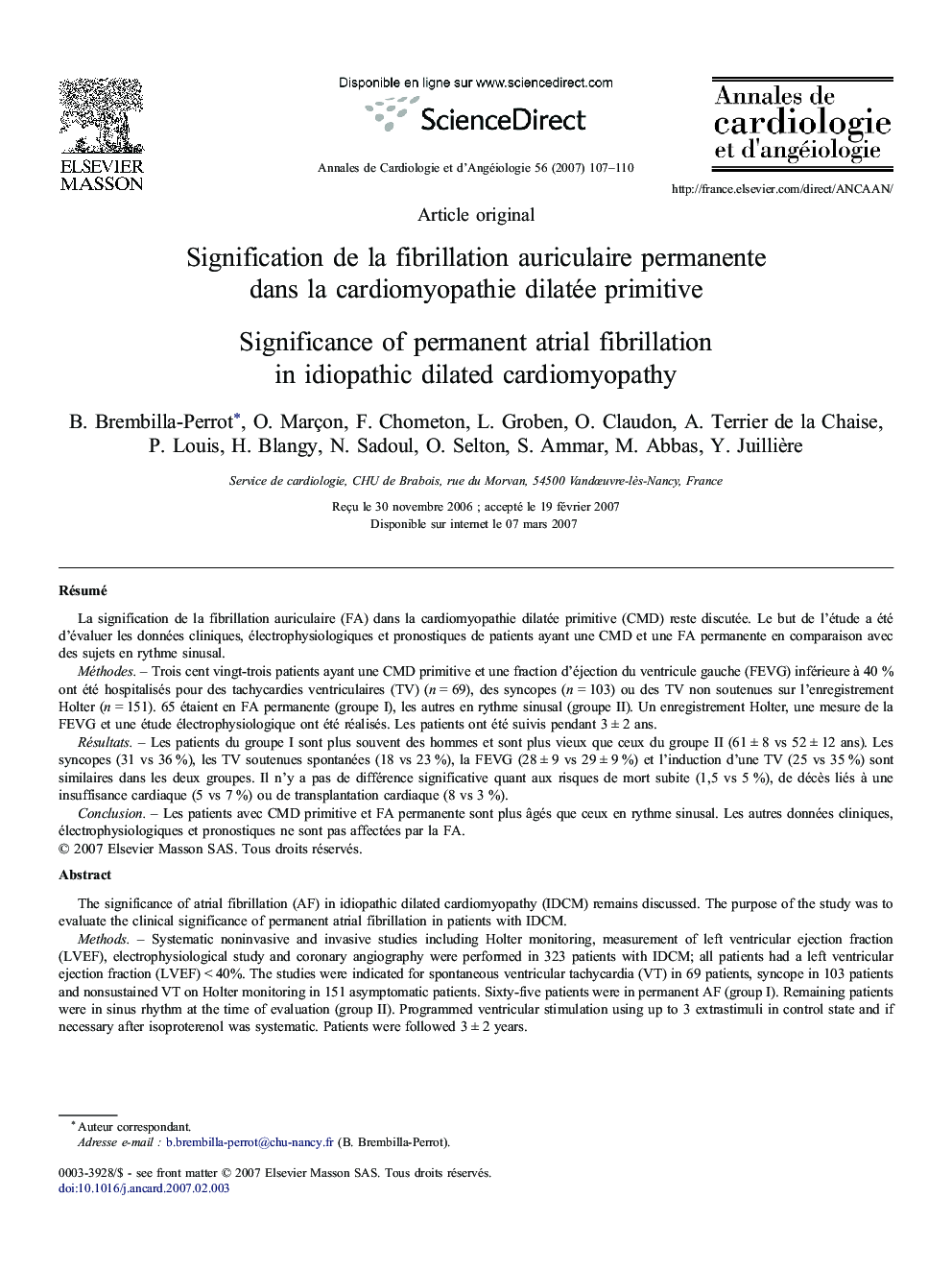| Article ID | Journal | Published Year | Pages | File Type |
|---|---|---|---|---|
| 2869337 | Annales de Cardiologie et d'Angéiologie | 2007 | 4 Pages |
RésuméLa signification de la fibrillation auriculaire (FA) dans la cardiomyopathie dilatée primitive (CMD) reste discutée. Le but de l'étude a été d'évaluer les données cliniques, électrophysiologiques et pronostiques de patients ayant une CMD et une FA permanente en comparaison avec des sujets en rythme sinusal.MéthodesTrois cent vingt-trois patients ayant une CMD primitive et une fraction d'éjection du ventricule gauche (FEVG) inférieure à 40 % ont été hospitalisés pour des tachycardies ventriculaires (TV) (n = 69), des syncopes (n = 103) ou des TV non soutenues sur l'enregistrement Holter (n = 151). 65 étaient en FA permanente (groupe I), les autres en rythme sinusal (groupe II). Un enregistrement Holter, une mesure de la FEVG et une étude électrophysiologique ont été réalisés. Les patients ont été suivis pendant 3 ± 2 ans.RésultatsLes patients du groupe I sont plus souvent des hommes et sont plus vieux que ceux du groupe II (61 ± 8 vs 52 ± 12 ans). Les syncopes (31 vs 36 %), les TV soutenues spontanées (18 vs 23 %), la FEVG (28 ± 9 vs 29 ± 9 %) et l'induction d'une TV (25 vs 35 %) sont similaires dans les deux groupes. Il n'y a pas de différence significative quant aux risques de mort subite (1,5 vs 5 %), de décès liés à une insuffisance cardiaque (5 vs 7 %) ou de transplantation cardiaque (8 vs 3 %).ConclusionLes patients avec CMD primitive et FA permanente sont plus âgés que ceux en rythme sinusal. Les autres données cliniques, électrophysiologiques et pronostiques ne sont pas affectées par la FA.
The significance of atrial fibrillation (AF) in idiopathic dilated cardiomyopathy (IDCM) remains discussed. The purpose of the study was to evaluate the clinical significance of permanent atrial fibrillation in patients with IDCM.MethodsSystematic noninvasive and invasive studies including Holter monitoring, measurement of left ventricular ejection fraction (LVEF), electrophysiological study and coronary angiography were performed in 323 patients with IDCM; all patients had a left ventricular ejection fraction (LVEF) < 40%. The studies were indicated for spontaneous ventricular tachycardia (VT) in 69 patients, syncope in 103 patients and nonsustained VT on Holter monitoring in 151 asymptomatic patients. Sixty-five patients were in permanent AF (group I). Remaining patients were in sinus rhythm at the time of evaluation (group II). Programmed ventricular stimulation using up to 3 extrastimuli in control state and if necessary after isoproterenol was systematic. Patients were followed 3 ± 2 years.ResultsMean age was significantly older in group I (61±8 years) than in group II (52 ± 12) (P < 0.01). Syncope (31 vs 36%), spontaneous sustained VT (18 vs 23%); mean LVEF (28 ± 9% vs 29 ± 9%), VT induction (25 vs 35%) were similar in both groups. During the follow-up, there were no statistical differences between groups I and II concerning each event: sudden death occurred in 13 patients, 1.5% of group I patients and 5% of group II patients (NS); a death related to heart failure occurred 22 patients, 5% of group I patients and 7% of group II patients (NS); heart transplantation was performed in 13 patients, 8% of group I patients and 3% of group II patients (NS).ConclusionsAn older age is the only significant clinical factor associated with the presence of a permanent atrial fibrillation in idiopathic dilated cardiomyopathy. The presence of permanent AF does not increase the induction of a sustained ventricular tachycardia and does not affect the general prognosis of IDCM.
